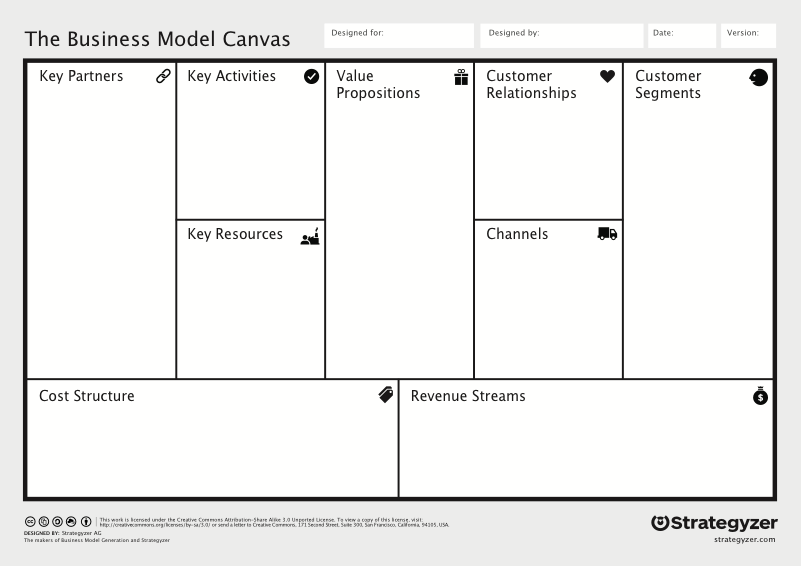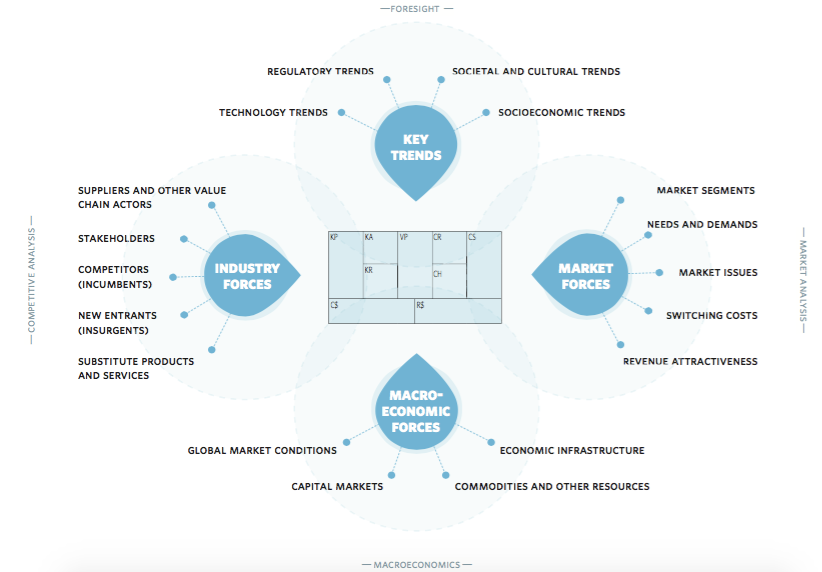The book Business Model Generation by Alexander Osterwalder and Yves Pigneur introduced a set of tools for business model innovation that became widely adopted in the tech industry, especially by startups.
Business Model Canvas
The most influential and well-known tool is the Business Model Canvas. Filling in the Canvas is often one of the first assignments for teams enrolled in startup schools around the world. The Canvas helps startups (and other types of businesses) define the nine building blocks of their business model:
- Customer Segments: Who are the customers, and does the value proposition match their needs?
- Value Propositions: What value is the business delivering to customers? What is the product or service? Which customer problems is it solving?
- Channels: Which communication, distribution, and sales channels work best to reach the defined customer segments?
- Customer Relationships: How will the business get, keep and grow the customer base?
- Revenue Streams: What is the revenue model? What value are the customers willing to pay for?
- Key Resources: Which resources are needed to deliver the value and other elements?
- Key Activities: Which activities are needed to deliver the value and other elements?
- Key Partnerships: What partners, suppliers, activities, and resources are needed from the outside?
- Cost Structure: What are the main costs of resources and activities needed for the business?

Source: Strategyzer
The Business Model Canvas (or the Lean Canvas, its startup adaptation) is also used to keep track of hypotheses a startup is testing and the changes in the business model as the startup pivots.
What the Canvas does well is putting customer needs front and center. Building products that people need and are willing to pay for can be an excellent first step toward reducing waste. Unfortunately, people often crave and pay for products and services that are bad for the environment (e.g., private jets, same-day delivery), have hidden social costs (e.g., poor working conditions of gig workers, social media moderators with PTSD), or both (e.g., poor mining conditions of rare earth elements that power our smartphones).
Without accounting for the social and planetary costs of the business model, the original Business Model Canvas will continue to contribute to businesses that look good on paper but have disastrous consequences for people and the planet.
Even the Environment map, which is part of the methodology, only considers market and industry forces and trends when describing the context for business decisions. While it’s likely that tech companies will face increasing regulatory demands and public demand for more responsible actions, there is certainly room for improvement in the original Canvas to make social and environmental costs and assumptions more explicit.
Responsible business models should include sustainability and social impacts among their key building blocks. This is why responsible companies should use one of the improved business model canvases that expose environmental & social costs and assumptions when defining their business models.
Business Model Environment
The Business Model Environment tool was designed as a companion to the Business Model Canvas to help businesses understand the content in which products or services are developed. The map covers four areas:
- Market Forces: Market issues and segments, needs & demands, switching costs, revenue attractiveness, and other relevant market characteristics.
- Key Trends: Technology, regulatory, societal & cultural, and socieconomic trends that affect the business.
- Industry Forces: Suppliers, stakeholders, existing and new competitors, substitute products and services, and everything else relevant in the industry.
- Macro-economic Forces: Macro trends, such as global market conditions, capital markets, commodities prices, economic infrastructure.

Source: Strategyzer
The Environment map adds much-needed context to the business model but doesn’t encourage the companies to go beyond the regulations and basic public expectations, which might lead to doing the bare minimum and greenwashing.
When looking at the business environment, responsible companies should go above and beyond business as usual. By setting new, more ambitious sustainability standards and socially responsible practices, companies can set themselves apart from the competition and make their business more future-proof.
